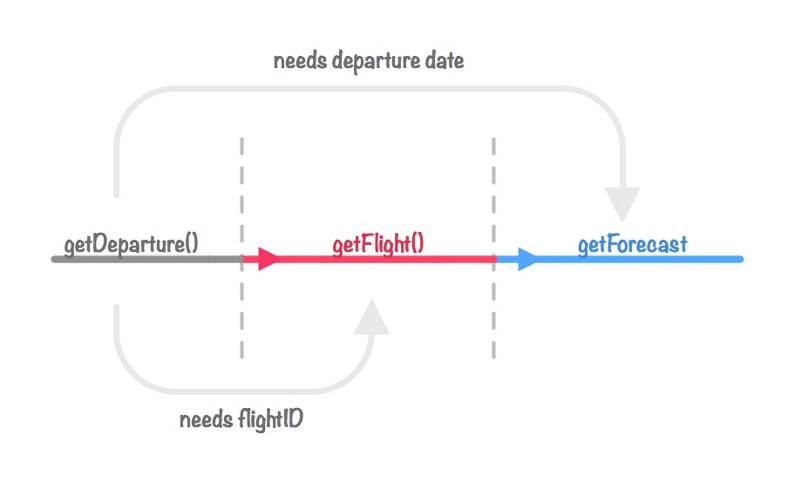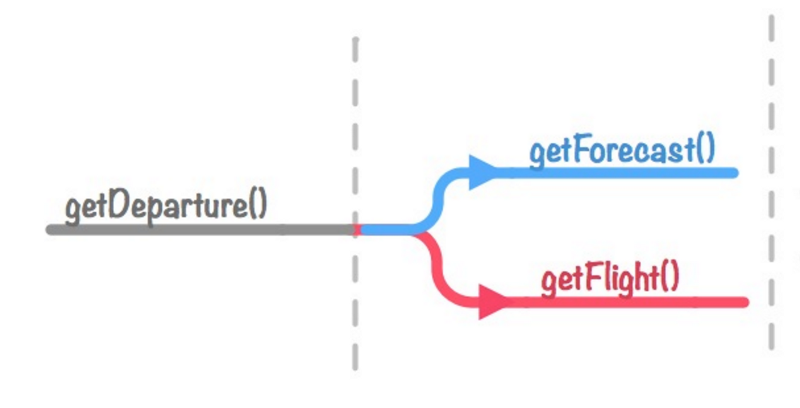by Andrés Mijares
Async operations using redux-saga

UPDATE August/2017:
- I published a second part of this article, Redux-saga common patterns
UPDATE April/2017:
- Thanks Eduardo for translating this article to Portuguese, find it here.
- Also this unknown guy for translating this article to Chinese, find it here.
A few days ago my colleague gave a talk about managing async operations. He was using several tools to extend the capabilities of redux. Listening to him really drove home the realities of JavaScript Fatigue.
Let’s face it: if you’re used to doing your job and using technologies based on your needs — and not for the sake of technology itself — setting up a React ecosystem can prove frustrating and time consuming.
I’ve spent the last two years working on Angular projects and enjoying the Model-View-Controller state of the art. And I must say that — even if the learning curve was an issue coming from a Backbone.js background — learning Angular has really paid off. I got a better job, and I also had the chance to collaborate on interesting projects. I learned a lot from Angular’s supportive community.
Those were really cool days, but, well, The Fatigue Must Go On (trademark pending), and I’m moving on with the fashion: React, Redux, and Sagas.
A few years ago, I came across with an article titled Flattening Promise Chains by Thomas Burleson. I learned a lot from reading it. Even two years later, I still recall a lot of these insights.
These days I’ve been migrating to React and I’ve found lot of power in Redux and using sagas to manage async operations. So I am writing this to borrow from Thomas’ post and create a similar approach using redux-saga. Here’s hoping this returns the favor to the universe and helps some folks understand how these important technologies work.
Disclaimer: I will work with the same scenario and extend it, I hope (if i’m lucky) to create a discussion about both approaches. I will assume the reader has some basic understanding of Promises, React, Redux and (d’oh!)... JavaScript.
First things first.
According to Yassine Elouafi, creator of the redux-saga:
redux-saga is a library that aims to make side effects (i.e. asynchronous things like data fetching and impure things like accessing the browser cache) in React/Redux applications easier and better.
Basically a helper library which allows us to organize all the asynchronous and distributed operations based on Sagas and ES6 Function Generators. If you want to know more about the Saga pattern itself, Caitie McCaffrey made a great job in this video and more about Functions Generators. Check this free Egghead video (at least it was free when I posted this article).
The Flight Dashboard Case
Thomas set a case that we are going to recreate. The final code is here, and the demo is here.
The scenario goes like this:

As we can see, a sequence of three APIs call: getDeparture -> getFlight ->getForecast, so our API service class looks like this:
class TravelServiceApi { static getUser() { return new Promise((resolve) => { setTimeout(() => { resolve({ email : "somemockemail@email.com", repository: "http://github.com/username" }); }, 3000); }); } static getDeparture(user) { return new Promise((resolve) => { setTimeout(() => { resolve({ userID : user.email, flightID : “AR1973”, date : “10/27/2016 16:00PM” }); }, 2500); }); } static getForecast(date) { return new Promise((resolve) => { setTimeout(() => { resolve({ date: date, forecast: "rain" }); }, 2000); }); }}This is a straight-forward API with some mocked information that will allow us to set the scenario. First we need to have a user. Then with that information, we’ll get the departure, the flight, and the forecast so we can create several ugly dashboards panels, which look like this:

The React components can be found here. They’re three different components with a representation on the redux store given by three reducers, which look like this:
const dashboard = (state = {}, action) => { switch(action.type) { case ‘FETCH_DASHBOARD_SUCCESS’: return Object.assign({}, state, action.payload); default : return state; }};We use a different reducer for each panel, with three different scenarios, which give the component access to the piece of the user using the StateToProps redux function:
const mapStateToProps =(state) => ({ user : state.user, dashboard : state.dashboard});After everything is setup (yeah I know I did not explain a lot of stuff, but I want to focus only on the sagas…) we are ready to play!
Show me the Sagas
William Deming said once:
If you can’t describe what you are doing as a process, then you don’t know what you are doing.
Ok, let’s create a step by step process of how to work with Redux Saga.
1. Register the Sagas
I will use my own word to describe which method are exposed by the API. if you need more technical detail, feel free to refer to the documentation here.
First we need to create our saga generator and register them:
function* rootSaga() { yield[ fork(loadUser), takeLatest('LOAD_DASHBOARD', loadDashboardSequenced) ];}Redux saga expose several methods called Effects, we are going to define several of them:
- Fork performs a non-blocking operation on the function passed.
- Take pauses until action received.
- Race runs effects simultaneously, then cancels them all once one finishes.
- Call runs a function. If it returns a promise, pauses the saga until the promise is resolved.
- Put dispatches an action.
- Select Runs a selector function to get data from the state
- takeLatest means we are going to execute the operations, then return only the results of the last one call. If we trigger several cases, it’s going to ignore all of them except the last one.
- takeEvery will return results for all the calls triggered.
We just registered two different sagas. We are going to define them later. So far, we take one for the user using fork and another takeLatest, which is going to wait for an action called “LOAD_DASHBOARD” to be executed. More info in step 3.
2. Inject the Saga Middleware into the Redux store.
When we define the Redux store and initialize it, most of time it will look like this:
const sagaMiddleware = createSagaMiddleware();const store = createStore(rootReducer, [], compose( applyMiddleware(sagaMiddleware) );sagaMiddleware.run(rootSaga); /* inject our sagas into the middleware*/3. Create the Sagas.
First, we are going to define the sequence of the loadUser Saga:
function* loadUser() { try { //1st step const user = yield call(getUser); //2nd step yield put({type: 'FETCH_USER_SUCCESS', payload: user}); } catch(error) { yield put({type: 'FETCH_FAILED', error}); }}We can read it like this:
- First, call a function called getUser, and assign the result to the const user.
- Later, dispatch an action called FETCH_USER_SUCCESS and pass the value of user to be consumed by the store.
- If something goes bad, dispatch an action called FETCH_FAILED.
As you can see, it’s really cool that we can add the result of a yield operation to a variable.
Now we’re going to create the sequenced saga:
function* loadDashboardSequenced() { try { yield take(‘FETCH_USER_SUCCESS’); const user = yield select(state => state.user); const departure = yield call(loadDeparture, user); const flight = yield call(loadFlight, departure.flightID); const forecast = yield call(loadForecast, departure.date); yield put({type: ‘FETCH_DASHBOARD_SUCCESS’, payload: {forecast, flight, departure} }); } catch(error) { yield put({type: ‘FETCH_FAILED’, error: error.message}); }}We can read the saga as follows:
- Wait for the FETCH_USER_SUCCESS action to be dispatched. This basically will be on hold until an event triggers it. We use the take effect for this.
- We take a value from the store. The select effect receives a function which has access to the store. We assign the user information to the constant user.
- We exec an async operation to load the departure information, and pass the user as parameter using the call Effect.
- After the loadDeparture is finished, we execute the loadFlight with the departure object fetched in the previous operation.
- The same will apply with the forecast, we need to wait until the flight is loaded to execute the next call effect.
- Finally, once all the operations are finished, we use the put Effect to dispatch and action to the store and send all the arguments using the information loaded during the whole saga.
As you can see, a saga is a collection of steps that wait from previous actions to modify their behaviors. Once finished, all the information is ready to be consumed in the store.
Pretty neat, eh?
Now let’s check a different case. Consider getFlight and getForecast can be triggered at the same time. They don’t need for one to finish in order to start the other, so we can create a different panel for that case.

Non-blocking Saga
In order to execute two non-blocking operations, we need to make a little modification to our previous saga:
function* loadDashboardNonSequenced() { try { //Wait for the user to be loaded yield take('FETCH_USER_SUCCESS'); //Take the user info from the store const user = yield select(getUserFromState); //Get Departure information const departure = yield call(loadDeparture, user); //Here is when the magic happens const [flight, forecast] = yield [call(loadFlight, departure.flightID), call(loadForecast, departure.date)]; //Tell the store we are ready to be displayed yield put({type: 'FETCH_DASHBOARD2_SUCCESS', payload: {departure, flight, forecast}});} catch(error) { yield put({type: 'FETCH_FAILED', error: error.message}); }}We have to register the yield as an array:
const [flight, forecast] = yield [call(loadFlight, departure.flightID), call(loadForecast, departure.date)];So both operations are called in parallel, but at the end of the day we can will wait for both to end to update the UI if needed.
Then we need to register the saga into the rootSaga:
function* rootSaga() { yield[ fork(loadUser), takeLatest('LOAD_DASHBOARD', loadDashboardSequenced), takeLatest('LOAD_DASHBOARD2' loadDashboardNonSequenced) ];}What if we need to update the UI as soon as operation is finished?
Don’t worry — I’ve got your back.
Non Sequenced and Non Blocking Sagas
We can also isolate our sagas and combine them, meaning they can work independently. That’s exactly what we need. Let’s take a look.
Step #1: We isolate the Forecast and the Flight Saga. They both depend on departure.
/* **************Flight Saga************** */function* isolatedFlight() { try { /* departure will take the value of the object passed by the put*/ const departure = yield take('FETCH_DEPARTURE3_SUCCESS'); const flight = yield call(loadFlight, departure.flightID); yield put({type: 'FETCH_DASHBOARD3_SUCCESS', payload: {flight}}); } catch (error) { yield put({type: 'FETCH_FAILED', error: error.message}); }}/* **************Forecast Saga************** */function* isolatedForecast() { try { /* departure will take the value of the object passed by the put*/ const departure = yield take('FETCH_DEPARTURE3_SUCCESS'); const forecast = yield call(loadForecast, departure.date); yield put({type: 'FETCH_DASHBOARD3_SUCCESS', payload: { forecast, }});} catch(error) { yield put({type: 'FETCH_FAILED', error: error.message}); }}Notice something very important here? This is how we architect our sagas:
- They both are waiting for the same Action Event (FETCH_DEPARTURE3_SUCCESS) to start.
- They will receive a value when this event is triggered. More detail on this in the next step.
- They will execute their async operation using the call Effect and both will trigger the same event after completion. But they both send different data to the store. Thanks to the power of Redux, we can do this without any modification to our reducer.
Step #2: Let’s make the changes to the departure sequence and make sure it sends a departure value with two other sagas:
function* loadDashboardNonSequencedNonBlocking() { try { //Wait for the action to start yield take('FETCH_USER_SUCCESS'); //Take the user info from the store const user = yield select(getUserFromState); //Get Departure information const departure = yield call(loadDeparture, user); //Update the store so the UI get updated yield put({type: 'FETCH_DASHBOARD3_SUCCESS', payload: { departure, }}); //trigger actions for Forecast and Flight to start... //We can pass and object into the put statement yield put({type: 'FETCH_DEPARTURE3_SUCCESS', departure}); } catch(error) { yield put({type: 'FETCH_FAILED', error: error.message}); }}Nothing different here until we get to the put Effect. we can pass an object to the actions and it will be yielded into the departure const in the departure and flight saga. I love this.
Feel free to see the demo, and notice how the third panel loads the forecast before the flight because the timeout is higher, to simulate a slower request.
In a production app, I’d probably do things a little different. I just wanted to point out that you can pass values when using the put effect.
What about testing?
You do test your code… right?
Sagas are easy to test, but they are coupled with your steps, are set into the sequenced due to the nature of generators. Let’s see an example. (And feel free to check the all the test in the repo into the sagas folder):
describe('Sequenced Saga', () => { const saga = loadDashboardSequenced(); let output = null;it('should take fetch users success', () => { output = saga.next().value; let expected = take('FETCH_USER_SUCCESS'); expect(output).toEqual(expected); });it('should select the state from store', () => { output = saga.next().value; let expected = select(getUserFromState); expect(output).toEqual(expected); });it('should call LoadDeparture with the user obj', (done) => { output = saga.next(user).value; let expected = call(loadDeparture, user); done(); expect(output).toEqual(expected); });it('should Load the flight with the flightId', (done) => { let output = saga.next(departure).value; let expected = call(loadFlight, departure.flightID); done(); expect(output).toEqual(expected); });it('should load the forecast with the departure date', (done) => { output = saga.next(flight).value; let expected = call(loadForecast, departure.date); done(); expect(output).toEqual(expected); });it('should put Fetch dashboard success', (done) => { output = saga.next(forecast, departure, flight ).value; let expected = put({type: 'FETCH_DASHBOARD_SUCCESS', payload: {forecast, flight, departure}}); const finished = saga.next().done; done(); expect(finished).toEqual(true); expect(output).toEqual(expected); });});- Make sure you import all the effect and functions helpers that you are going to test.
- When you store a value on the yield, you need to pass the mock data to the next function. Notice the third, forth and fifth test.
- Behind the scene, each generator moves to the next line after a yield when the next method is called. This is why we use the saga.next().value here.
- This sequence is set in stone. If you change the steps on the saga, the test won’t pass.
Conclusion.
I really like to test new technologies and in the front end development, we find new stuff almost on daily basis. It’s like a fashion: once something is accepted by the community, it’s like everyone wants to use it. Sometimes I find a lot of value in these things, but it’s still important to sit down and check to see whether we really need something.
I’ve found thunks easier to implement and maintain. But for more complex operation, Redux-Saga does a really great job.
Once again, I thank Thomas for the inspiration for this post. I hope someone finds as much inspiration in this post as I did in his :).
If you have any questions, feel free to tweet at me. I’m happy to help.
If you happen to be more interested about this topic, feel free to check the part 2 of this serie Redux-saga common patterns.
the mediocre engineer
For more content like this, please consider subscribe to my channelwww.youtube.com
Finally feel free to check my open source projects at the moment:
